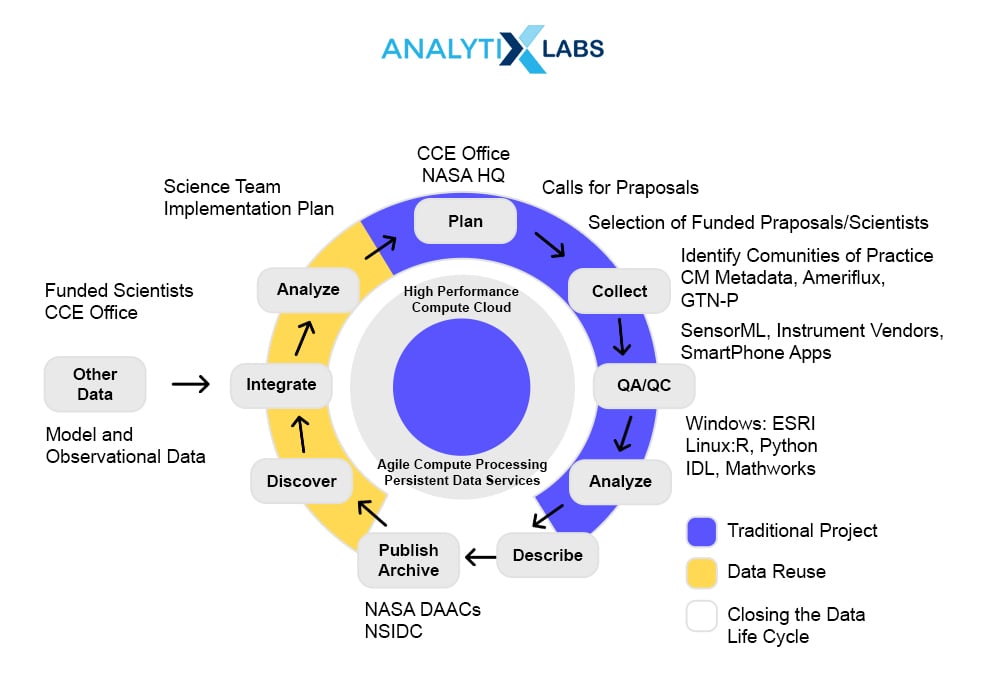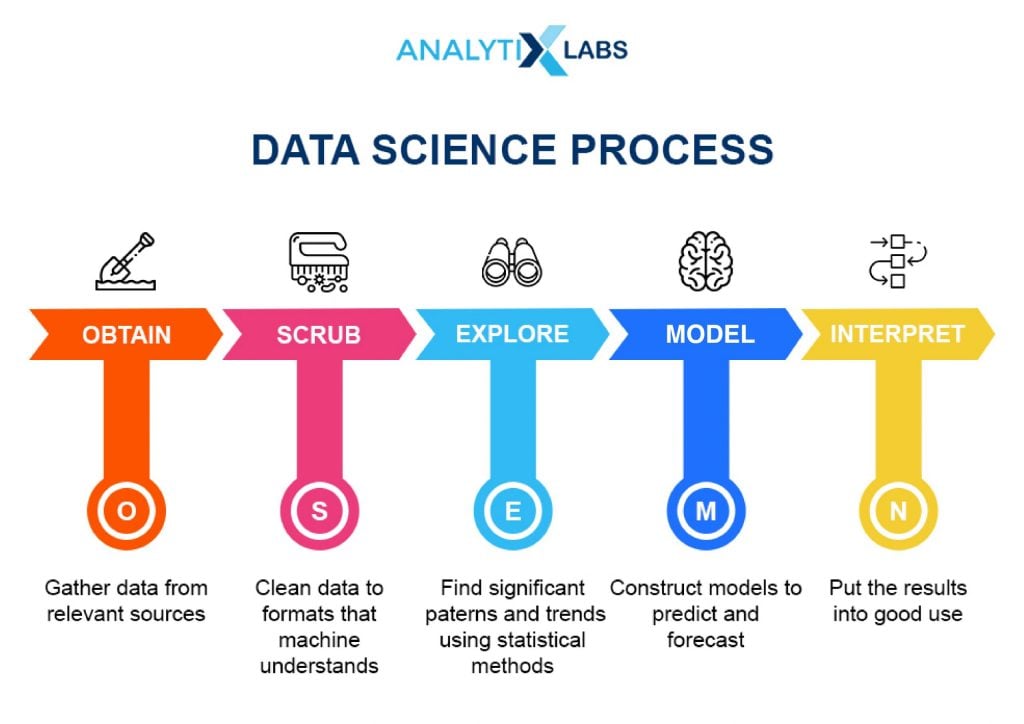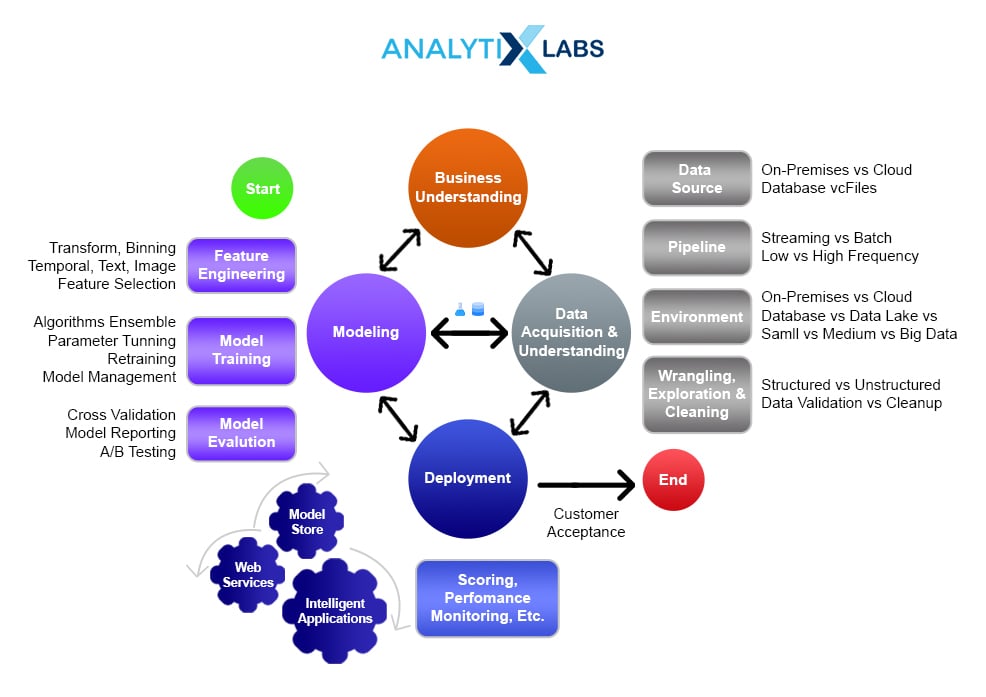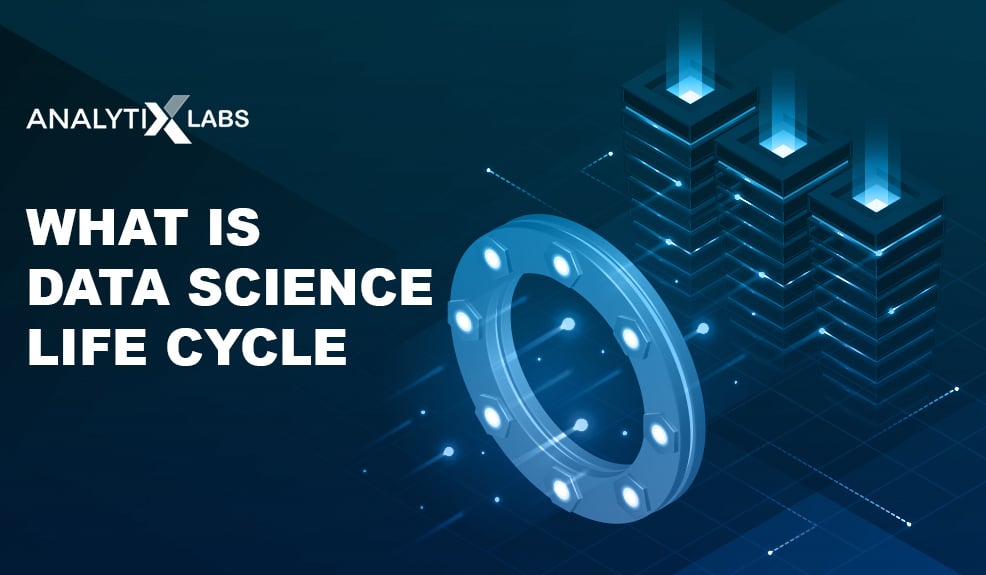The term “Data science” was first coined by Dhanurjay Patil, who served as the Chief Data Scientist of the United States Office of Science and Technology Policy. Jeff Hammerbacher, another fellow data and computer scientist, in 2008. Since the acceptance of data science as an area of specialization that requires more research, data science has been rapidly adopted for further specialized studies to assist a more efficient, fluid, automated, and smoother technology experience. A data science life cycle refers to the established phases a data science project goes through during its existence. These steps or phases in a data science project life cycle are specified by the life cycle of data science. It is beneficial to use a well-defined data science life cycle model, which offers a map and clear understanding of the work that has to be done in a data science project. This article will discuss this process and data science life cycle details.
What Is a Data Science Life Cycle?
From its creation for a study to its distribution and reuse, the data science life cycle refers to all the phases of data during its existence. The life cycle of data starts with a researcher or a team creating a concept for a study, and the data for that study is then collected once a study concept is established. After data is obtained, it is prepared for distribution to be archived and used by other researchers at a future stage. When data enters the distribution point of the life cycle, it is contained in a location where other researchers can then discover it.
The following illustration describes an example of the life cycle of data science at NASA. Understandably, for beginners, this may be overwhelming at the moment, and you will read more through this blog; different pieces will fall into place.

What Is the Five-stage Life Cycle in Data Science?
The OSEMN framework is a great data science life cycle example to refer to. This framework covers the five stages of a data science life cycle. These are essentially 5 phases a data science project life cycle goes through to be successful.

The five stages are as follows:
- Obtaining the Data: This stage involves using technical knowledge like MySQL to process and generate the data. It can even be in simpler file formats such as Microsoft Excel. Some examples like Python and R even directly import the datasets into a data science program.
- Scrubbing the Data: This stage involves cleaning raw data to retain only the relevant part of the processed data. The noise is also scrubbed off, and the data is refined, converted, and consolidated.
- Exploring the Data: This stage consists of examining the generated data. The data and its properties are inspected since different data types demand specific treatments. Descriptive statistics are then computed to extract the features and test the significant variables.
- Modeling the Data: The dataset is refined further, and only the essential components are kept. Only relevant values are kept and tested to predict accurate results.
- Interpreting the Data: At this stage, the final product is interpreted for the client or business to analyze if it meets the requirement or answers a business question. The insights are shared with everyone, and the results of the final stage are visualized.
What Are the Key Steps of a Data Science Project?

A data science project has a few fundamental milestones which need to be met as the project moves forward. Here are the key steps of a data science project life cycle.
Business Requirement and Understanding: Understanding the needs of the business or client and getting an idea of the problem
The problem or requirement is properly understood and the specifics are discussed.
Data Generation and Understanding: The available data which can be used and the data which needs to be generated is analyzed and discussed. This is one of the fundamental data science life cycle steps as it deals with understanding the data requirement and gathering the data.
Data Preparation: This part of the process deals with preparing the raw data by cutting out the noise and irrelevant information. This is a time-consuming process because it deals with the cleaning and fine-tuning of data from datasets that are relevant and won’t lead to the corruption of the model.
Modeling of Project: The project is modeled, and different variations are tried out before deciding upon the final one with statistical and analytical means.
Evaluation of Model: This stage deals with finding out if the model is good enough before deployment. It is checked if the model can tackle a business problem or serve the business requirement.
Deployment of Model and Communication: The model is deployed and monitored. Basic communication is done regarding the model in regards to optimization and maintenance.
Which Is the Most Important Thing in Data Science?
The most important thing in Data Science to understand the business context and organizational needs for which Data Science is put to use. Often, professionals are too focused on the technicalities and fancy algorithms and lose the focus on the actual business outcome or organizational objectives, without achieving any Data Science project has almost no purpose. So it becomes imperative for any Data Science professional to keep the end objective and business questions in consideration right from the beginning.
The other very important thing in data science would be a good grasp of the mathematical and fundamentals of statistics for Data Science. Mathematical concepts such as linear algebra, distributions, and probabilities are important for data science and help to work on Data Science projects in a more meaningful way. . Similarly, a solid foundation in statistical concepts such as inferential and descriptive statistics is highly recommended. Many programming languages can be used for data science, but a good knowledge of prominent tools like Python, SQL, and R helps immensely.
Related: How to Become A Data Scientist – Step By Step Guide
What Is the Data Science Process?
The Data Science process consists of all the key steps involved in a Data Science project. A Data Science process life cycle example would consist of framing the problem or requirement and then collecting the raw data required. The data is then processed for analysis, and the data are explored. In-depth analysis and testing with statistical tools are then performed to conclude the project. The results are then shared with the concerned entities.
You may also like to read: What Is Data Science Process, Steps Involved, and Their Significance?
You can enroll in our great data science course and our exclusive PG in Data Science course course at your convenience, or you can book a demo with us.
Conclusion
With the advent of Deep Learning, AI, Complex Data requirements, and more efficiency, there has never been more importance put into Data Science. The Data science life cycle is one of the basic concepts that should be covered and studied to understand the life cycle of data science project successfully.
FAQs – Frequently Asked Questions
Q1. What is data science methodology?
Data Science Methodology is a systematic series of techniques that guides data scientists through a specified sequence of steps to the ideal approach to solving data science problems.
Q2. How is data science used in healthcare?
Medical imaging is one of the most powerful applications of data science in healthcare. Computers learn how to view X-rays, mammography, MRIs, and other image forms, recognize data patterns and detect tumors, stenosis of the artery, abnormalities of the organ, and more. It is possible to detect a health problem by taking past historical data from other patients, a patient’s trends, and genetic details into consideration before it gets out of control. This assists doctors and patients both to detect issues with a patient’s bodies beforehand. Big data helps scientists simulate a drug’s reaction to body proteins and various cell types and conditions to have a higher chance of being effective hence highly supporting drug discoveries. In hospitals, predictive analytics may make scheduling more efficient and tell hospital workers which beds should be cleaned first and which patients during the discharge process can face difficulties.
Q3. At what stage of the Data Science life cycle do you optimize the parameters?
Parameters are optimized in the last stage of the implementation of a data science project. This phase is known as the monitoring or closure phase. This is fundamentally the end-point of a typical Data Science project. Every day, vast quantities of data are analyzed and generated. Therefore there is a definite need for the models to keep learning and getting trained. The models of Data Science need to adjust to this fresh information. This is different from retraining or remaking since this stage is nothing but preserving the model’s efficiency by taking appropriate steps. This also prevents any data loss or a future system malfunction. This process is referred to as optimization within the data science life cycle steps.
Q4. What are tools used for Data Science?
Many tools are used for data science. For AI and machine learning, Python, R, and Apache Spark are most preferred. Microsoft Excel and SQL are preferred as well due to their simplicity. There are many other tools like Tableau, Alteryx, MATLAB etc. which are also very popular.
AnalytixLabs offers a wide range of Data Analytics Training Courses to prepare you for a successful career in data science and machine learning. AnalytixLabs methodically creates every course and maps it in accordance with job roles in Data Engineering, AI, and Data Science.
With the increasing need for data science, we need to be more familiar with data science life cycle details and data science tools. Please drop a comment below if you want to hear back from us or in the case of any inquiry. We would love to hear your opinions and answer your queries!
You may also like to read:
1. Why Python for Data Science is Industry’s Top Choice?
2. 50 Ultimate Python Data Science Libraries to Learn in 2021





![Understanding Binary Tree: Guide to Binary Tree Implementation in Python[with codes] binary tree in data structure](https://www.analytixlabs.co.in/blog/wp-content/uploads/2024/10/Binary-Tree-in-Data-Structure-01-370x245.jpg)


